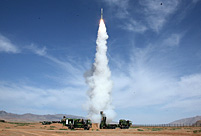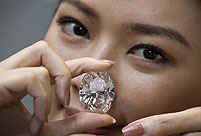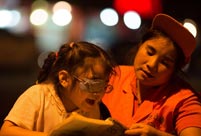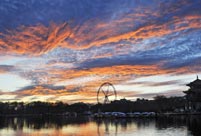 |
| (Photo/China Daily) |
As the nation experiences an explosion of public art amid rapid urbanization, questions concerning controversy and the public good arise.
Whether you think it's creative or not, Florentijn Hofman's Rubber Duck proves that a common object such as a child's bath-time friend can inspire the birth of a public art work, winning popularity and arousing commercial interest.
The craze for the giant bird has spread from Hong Kong to Beijing, and is further fueled by massive copies. When Hofman's original work debuted in Beijing's Garden Expo Park, another yellow rubber duck, dressed in a green waistcoat and followed by seven green eggs in a line, was unveiled on the lake at Beijing's Yuyuantan Park.
Beyond the interest in the giant duck, one can see a growing appetite for public art, which is backed by a growing number of urbanities on the mainland.
Recent years have witnessed an eruption of landmarks of city culture, mostly in the form of gigantic sculptures. Yet few of them are pleasant to look at, or at the least bring the simple joy the yellow bird has conveyed to its viewers.
A century ago, only 10 percent of the world's population lived in cities. The ratio grew to 50 percent by the end of the 20th century. Amid a global wave of rapid urbanization, China has ascended to the rank of countries that boast the fastest-expanding urban communities.
 |
 Storms leave 97 dead, 58 missing in Mexico
Storms leave 97 dead, 58 missing in Mexico New model of indigenous surface-to-air missiles testfired
New model of indigenous surface-to-air missiles testfired  118.28-carat diamond to be auctioned in HK
118.28-carat diamond to be auctioned in HK Maternal love under streetlight
Maternal love under streetlight Naked foreign student sits in the middle of a road in Haikou
Naked foreign student sits in the middle of a road in Haikou  Colorful Yunnan: Enjoy the natural beauty
Colorful Yunnan: Enjoy the natural beauty Harbin named Chinese city with most beautiful women
Harbin named Chinese city with most beautiful women New college students' military training in Guangzhou
New college students' military training in Guangzhou Rugby girls
Rugby girls PLA's 38th Group Army conduct training
PLA's 38th Group Army conduct training Residences of the royal house of Savoy
Residences of the royal house of Savoy The last days of Wan Aihua
The last days of Wan Aihua Highlights at 12th National Games of China
Highlights at 12th National Games of China Beijing Film Academy welcomes freshmen
Beijing Film Academy welcomes freshmen 2013 Taiwan Int'l Tourism Expo kicks off in Taipei
2013 Taiwan Int'l Tourism Expo kicks off in TaipeiDay|Week|Month